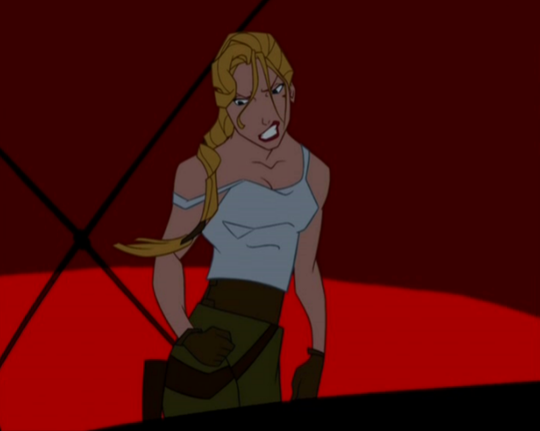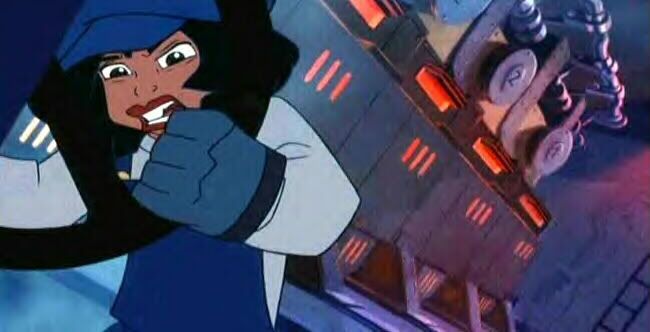Another character-driven animated tale from Disney, the 2001 film Atlantis: The Lost Empire once again features a male-dominated cast of characters. However, of the handful of females who exist among the main and supporting characters, all stand out as women who shatter the gender norms enforced by the society of their time and of our society in general. Set in 1914, over two decades prior to the release date of Disney’s Snow White, Atlantis features three female characters in particular who are the polar opposites of the 1937’s ideal princess.

The audience’s first encounter with one of the film’s female characters follows Milo’s failure to convince the museum staff to fund an expedition to search for the Shepherd’s Journal, the key to finding Atlantis. When he arrives home, dejected, he finds Lieutenant Helga Sinclair waiting in his house, wearing a slinky, seductive dress and dropping sarcastic comments left and right. She embodies a typical femme fatale character type, immediately presenting herself as a sexy, capable, and even dangerous woman. After convincing Milo to return with her to the home of her employer, she briefly vanishes from the film. When Helga finally reappears, she is dressed in a military uniform and supervising the preparations for the upcoming Atlantis expedition funded by her employer. Helga’s sudden switch from dangerous temptress to stern military woman lies completely within her character, but it is clear that she prefers to function in the latter sense. She is revealed throughout the movie to be a morally dubious character, interested in looking out for her own interests. Although she shows unclear emotions of pain or sadness immediately following the sinking of the submarine and a great loss of life, she remains otherwise emotionally detached, doing her duty to look out for those under her command but refusing to soften to the plight of Atlantis. Whereas female characters are traditionally shown as ruled by their emotions, either on the surface or buried beneath fake apathy, Helga’s character makes it clear that her personality and decisions are governed by her brain rather than her heart. She can be just as callous as her male counterpart, Commander Rourke, with whom she stands until he makes it clear that he views her as the inferior partner. Defiant to the end, when Rourke throws her from the dirigible in order to lighten the load and aid his escape, Helga retaliates by shooting the dirigible down and foiling his plan.

Helga is not, however, the only woman in a position of power on the multi-million dollar expedition to Atlantis. Audrey Ramirez is introduced as the Chief Mechanic, responsible for maintaining the various vehicles used in the search for the lost empire. Not only is Audrey a woman, but she also a woman of color—of a Puerto Rican background—and a teenager, the youngest crew member to hold such a position. Despite all these factors, Audrey defies any societal expectation one might have of her, approaching her profession with obvious skill and enjoyment. Just as Helga’s character can be pegged as the femme fatale, Audrey’s character might be pegged as the tomboy, as she embodies no hint of traditional femininity, instead choosing to fit in as “one of the guys.” She wears baggy overalls that obscure her figure, she routinely punches Milo, and she isn’t afraid to get up close and personal when working on the engines. These characteristics are explained in the discussion of her backstory, when she reveals that her father always wanted two sons: one to become a champion boxer, and the other to run his mechanic shop. Instead, he ended up with two daughters, both of whom ended up following his dreams for them, becoming successful females in traditionally male-dominated fields. Although Audrey rejects a great deal of traditional femininity, she does show a greater sense of caring and adherence to a moral code than Helga, changing sides before the final struggle in order to aid the people of Atlantis. However, this sense of caring never becomes a weakness, for Audrey holds her own throughout the film, doing what she believes is right and giving it everything she’s got.

The main female lead, however, is the Princess Kidagakash, known as Kida. Unlike previous Disney princesses, Kida is a skilled warrior and leader of her people, making it clear from the beginning that it is her responsibility to revive her dying culture. Kida’s title does not merely set her up as the stepping stone for the future king; her father specifically mentions that his position as ruler will fall to her upon his death, and that she will govern Atlantis as the queen. Because she is expected to one day be the leader rather than to one day marry the leader, Kida demonstrates herself to be a decisive, responsible character, tackling problems as they arise rather than aspiring to become a docile symbol in the background of the royal leadership. Kida is intelligent, questioning the faults in her society and her father’s reluctance to move forward, and she actively works to learn about the culture’s forgotten past in order to preserve its future. When the expedition from the outside world reaches Atlantis, Kida immediately recognizes Milo’s skills as a linguist, and she approaches him to help her decipher the texts that have been lost to her people following the Great Flood.

When Rourke reveals that his involvement in the mission is as a mercenary, seeking out the mysterious Heart of Atlantis to sell as a power source to the highest-bidding nation, Helga captures Kida at gunpoint and forces Milo to lead them to the Heart of Atlantis. When they encounter the large crystal, suspended like a miniature sun in an underground cavern, Kida is drawn to it, merging with the crystal as it senses the danger to the city. After Rourke has locked Kida and the crystal away, planning to transport them back to the surface, the King reveals to Milo that the same fate befell Kida’s absent mother, who merged with the crystal and was thus able to protect the city from the Great Flood, saving the civilization and its people by submerging it and hiding it away. However, Kida’s mother remained bonded with the crystal for too long, losing herself permanently within it. In order to rescue Kida from this fate, Milo leads a team to steal her back from Rourke, a rescue that does and does not fit in with the actions of the traditional Disney hero. Milo is not a warrior like Kida, but a scholar, and he cannot singlehandedly save the girl. He relies on the help of his friends, and it is through the actions of many that Kida is restored to Atlantis. However, the explosion of Rourke’s dirigible during the rescue attempt causes a volcanic eruption to take place, which would wipe out the city without Kida’s intervention. Freed from her prison, Kida uses the power of the crystal to save Atlantis and its people, following in the footsteps of her mother. After the city is saved, she is restored to her body, and with the death of her father (following Rourke’s earlier attack on him), Kida becomes the Queen of Atlantis.

The relationship between Kida and Milo is much more subtle than many other Disney relationships, and it is implied that they take it slow, getting to know each other rather than rushing into a marriage as is typical in the Disney canon. They share many onscreen interactions, and toward the end of the film they are seen to hug and to hold hands, but perhaps alone of all Disney couples, they do not share the climactic onscreen kiss. Furthermore, their relationship is built entirely on the equality between them and their mutual respect for one another. Milo does not embody the traditional brawny male, and Kida does not embody the traditional docile woman. They instead respect each other’s intellect and differing skills, and they each take on aspects traditionally associated with femininity or masculinity. Milo’s relationship with Kida does not detract from her authority as the queen; although he is the male, the monarchy of Atlantis is based on ancestry rather than gender, and Kida is unequivocally recognized as the leader of her people. Perhaps this strength of character is ahead of its time, however, as Kida is not recognized in the official lineup of Disney Princesses.

No comments:
Post a Comment